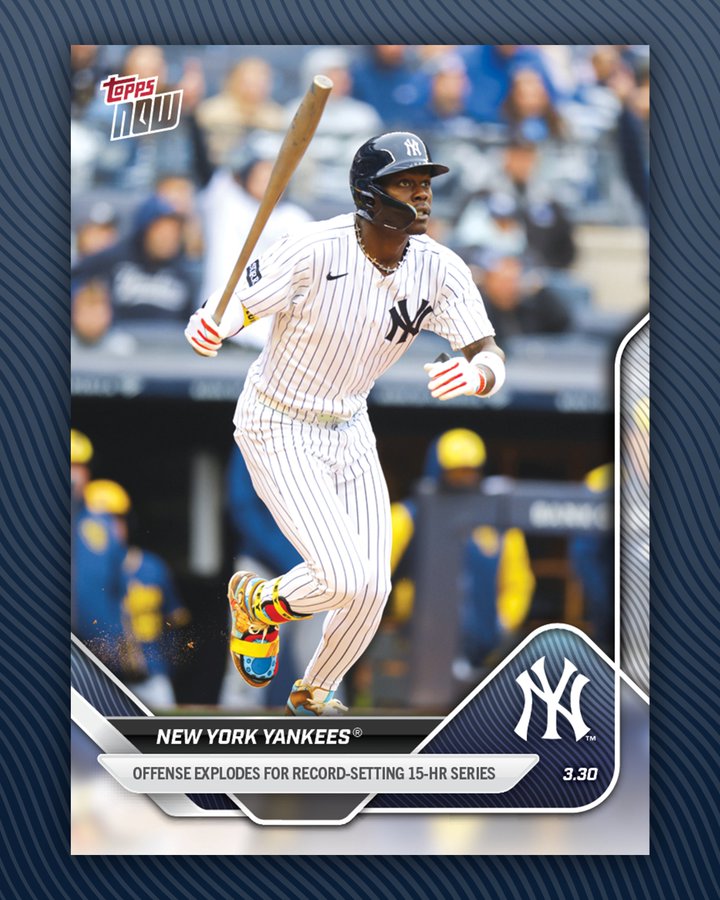In the ever-evolving landscape of America’s favorite pastime, baseball has found its newest revolutionary catalyst: the “torpedo” bat. This cutting-edge addition to the game is not just altering the dynamics on the field, but it’s also shaking up the world of baseball card collecting in an unprecedented manner.
This latest innovation is more than just a tweak to the traditional bat design; it’s a game-changer. The “torpedo” bat earns its name from its distinct, streamlined shape, specifically crafted to suit the swing and preference of individual players. If you thought the age of towering home runs was already in full swing, these custom-designed bats have catapulted it into hyperdrive.
The New York Yankees made headlines recently with their explosive performance against the Milwaukee Brewers in the opening series of the season, where they launched a staggering 15 home runs, including an eye-popping nine in a single game. This remarkable feat was achieved not by chance, but rather fueled by the widespread adoption of the torpedo bats, which have turned each game into a potential home run derby.
For avid baseball card collectors, the message couldn’t be clearer: stake your investments on the big hitters. The soaring trajectory of baseballs correlates seamlessly with the upward trend in the value of player cards. Case in point: although Yankees superstar Aaron Judge has not yet adopted the torpedo bat himself, the environment cultivated by his teammates’ power-hitting prowess has sent the value of his cards through the roof. It seems that collectors are less concerned with technicalities when gleaming home runs are involved.
The ripples of this new trend extend beyond hitters, affecting the card values of pitching stalwarts. Paul Skenes, the reigning National League Rookie of the Year, may find his cards losing allure. The challenge for pitchers is becoming increasingly daunting, akin to competing in a league now seemingly tilted in favor of the offensive juggernauts. This shift could also impact young pitching talents like Jackson Jobe of the Detroit Tigers and Roki Sasaki from the Los Angeles Dodgers, unless Major League Baseball steps in with regulatory measures to preserve balance in the game.
And then there’s the phenomenon known as Shohei Ohtani, the double-threat whose versatility could become even more prized. As fans and collectors speculate, this might just be the year Ohtani leans more heavily into hitting. With torpedo bats rendering pitchers as mere targets for home run spectacles, Ohtani might find the allure of more frequent dingers irresistible. For Los Angeles Dodgers fans and collectors alike, this potential shift is eagerly anticipated; after all, more Ohtani heroics translate to a lively market for his cards.
For pitchers across the league, the adjustment to this torpedo bat era poses a formidable challenge. Strengthening their mental and physical game is imperative, as their legacy—and their card values—could very well be at stake. As much as these bats might represent a headache on the mound, they are simultaneously a boon for fans who thrive on the electrifying excitement of the long ball.
In this burgeoning home run bonanza, collectors find themselves on a treasure hunt, digging deep to acquire the cards of burgeoning sluggers who wield the magic wands of the moment. Savvy insiders recognize this shift as an opportunity to buy low and sell high in a thriving market where potential and performance translate directly into value.
While the torpedo bats capture the immediate spotlight, the ripple effects on baseball as a sport, a pastime, and a collectible market will undoubtedly unfold as the season progresses. The union of tradition with innovation is lighting up stadiums and card trading alike, infusing a potent thrill into both spectating and collecting.
As the season rolls on, fans, players, and collectors eagerly anticipate how MLB will respond to this boom in offensive productivity. Rule changes, technological improvements, and strategic shifts are all potential avenues as the league grapples with creating equilibrium in the face of this hard-hitting innovation.
With anticipation building to see whether pitching talent can adapt and counter this new wave, the symbiotic relationship between modern technology and traditional sport has never been more pronounced. Baseball, the timeless game, is once again at a crossroads, deftly walking the line between its storied past and its ever-evolving present, all while keeping fans on the edge of their seats, eager for the next electrifying display of batting prowess.
In the world of baseball cards, the success story of the torpedo bat continues to be written, page by page by the hands of collectors choosing which players, poised with bats reminiscent of nautical projectiles, will define the new era of the collected card. This season and beyond, the diamond’s narrative is shaped by those bold enough to swing for the fences and those wise enough to grasp at their collectible effigies. Baseball is a game of very fine and exact traditions, but every crack of the torpedo bat is an invigorating reminder: the future waits for no one.
